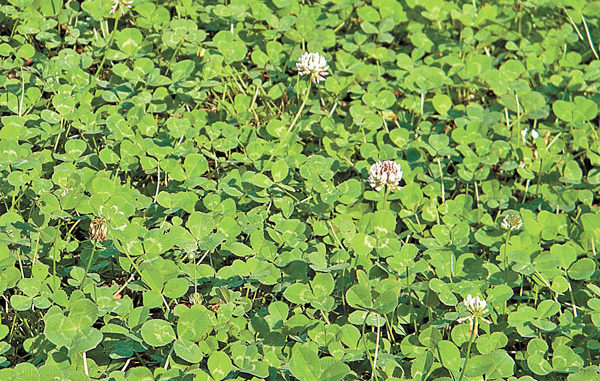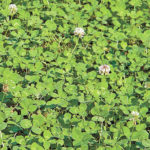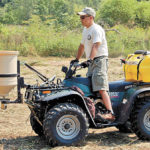
Food plots have critical periods, with some parts of the year more important than others. In the spring, herbaceous and woody plants end their dormancy and begin competing for available nutrients, sunlight and space. The race is on, and land managers must have their food plots prepared to unleash their full potential for providing healthy nutrition for wildlife.
Springtime conditions and the “famed” April showers invigorate every herbaceous and woody plant species. Land managers should make sure the right plant groups are available to receive the seasonal goodness and later benefit wildlife species.
Perennial clovers such as red, white and alsike are the ticket, with their highly palatable greens and robust, raw protein content that approaches nearly 30 percent. They have a home in every food plot in the south, whether managing for furred or feathered game species.
Deer and wild turkey flock to perennial food plots during this critically important time of year. Deer require rich food sources in spring and early summer; does prepare to drop their fawns in spring and need rich forage to fuel milk production for the newborns. Smooth, velvety, antler pedicles begin forming in May, and bucks will soon need supplemental nutrition to grow big racks through the summer. Premium food plots also provide wild turkey poults with tender forage and will serve as a classroom for Bugging 101.
Clover plots are often regarded as one of the most-beneficial wildlife crops available, and for good reason. The leaves, blooms and stems all contain nutritional qualities. Besides nearly 30-percent protein, clover is high in vitamin C, iron and many other healthful minerals. Perennial clover plots should be maintained, and several techniques are available to preserve the continuation of these nutrient-rich food sources.
Perennial clover plots bulk up during springtime. Vigorous weeds and woody plants also prefer the available nutrients and springtime circumstances. Invasive weeds often plague perennial food plots in warm months. and they must be controlled using appropriate chemical or physical retardants. Invasive weeds come in two forms; grasses and broad leafs. Common grasses invading food plots generally can be isolated as crabgrass, fescue and Johnson grass. These grasses can be chemically-controlled with Sethoxydim, more commonly-known as Vantage, manufactured by Dow Agrosciences. Broadleaf weeds such as ragweed, nettle and milkweed can be controlled with 2-4D, commercially-known as Ortho’s Weed Be Gon Max. However, perennial clovers are also broadleaf species, and a diluted mixture should be used to select for the invasive weed. When using herbicides for grasses or broadleaf weeds, read labels carefully to ensure proper application.
Fortunately for clovers, the majority of the energy reserves are stored with the root system, and weeds in clover patches can be physically controlled. Mowing will kill other broadleaf species, consequently boosting vegetative growth in perennial clovers as well. However, a combination of chemical and physical control will produce the best results.
Fertilize and supplemental lime application
Energy and nutrients inoculated into the soils and then into food-plot forage will be transferred into muscle and fat in the animals that feast on these forage materials. Basically, energy-in will roughly equal energy-out. Any high-production food plot with recurring activity and foraging from wildlife will eventually deplete elemental soil characteristics over time. Supplemental fertilization in perennial food plots should be a routine occurrence and is especially important before spring surge.
Even though red, white and alsike clovers often fixate nitrogen in the soil, woodland soils often lack necessary potassium and phosphorus critical for optimum clover growth. These elemental minerals must be applied to existing and future clover plots to provide the necessary components needed by clover plants. Fertilizer high in potassium and phosphorus — such as 6-24-24 or 0-20-20 — should be applied before the spring growing season. Fertilizers should be applied by a liquid means or top-dressed using a granular application method. As a general rule, 250 to 300 pounds per acre should be applied to affect the growth of the perennial food plot in a positive way.
Woodland soils in the south also are naturally acidic, but clover prefers nearly neutral pH soils. Over time, soils become more acidic as acidic compounds leach from adjacent forests or other acidic sources through overland or subterranean flows. Clover plants are unable to utilize critical fertilizer minerals unless pH levels approach neutral conditions. However, adequate liming before initial planting of around two tons per acre will maintain a nearly neutral pH for several years. A soil test will confirm the pH and what level of liming should be considered, but light periodic liming never hurts and will ensure the adequate pH range preferred by clover varieties.
In order to provide the best of both worlds, a mixture of fertilizer and granulated lime top-dressed throughout the perennial clover plot will ensure continuous forage production for deer and other species of wildlife.
Thicken plots through over-seeding
Springtime is here, and it’s definitely time for sprucing up premium forage centers for deer and other wildlife. While invasive weedy competition and other environmental conditions commonly spoil premium food plots, perennial plots often requires supplemental planting assistance from time to time to continue providing wildlife with premium forage.
After perennial food plots have been available for a period of several years, wildlife begin to rely on them in spring and summer to fulfill their intense cravings for quality forage. If managed correctly, these food plots can produce forever, but environmental factors will eventually disrupt the homogenous nature of these premium plots.
Not every food plot will be consistent from one end to the other. Through uneven herbicide treatments, weed invasion and just thinning of desired coverage, perennial food plots must be over-seeded to continue to provide wildlife with a thick, lush stand of protein-rich forage. Since clover seeds are so small and require little cover, over-seeding clover plots is very effective. Clover should be broadcasted using a rotary spreader or by hand application evenly distributed throughout the thin areas. Quantity of seed per acre will vary depending on the current stand. But, as a general rule, one-third the seeding rate for a new plot should be used or approximately seven to eight pounds per acre.
Jeff Burleson is a 37 year-old native of Lumberton, N.C., now living in Myrtle Beach, S.C. He graduated from N.C. State University with a degree in Fisheries and Wildlife Sciences and is a biologist and registered professional forester in North and South Carolina for The Brigman Company.






Be the first to comment